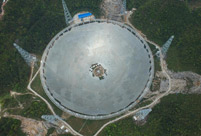


(File photo)
According to news released during the Beijing-Tianjin-Hebei Innovative Synergetic Development Conference, in the past ten years, China has made great achievements in energy conservation and emission reduction and the efficiency of energy use has been significantly improved. From 2005 to 2015, China's overall energy savings have totaled to 1.57 billion tons of standard coal, which is equivalent to 3.6 billion tons of carbon dioxide emissions.
From 2005 to 2015, the proportion of coal used in China's total energy consumption has dropped from 72 percent to 64 percent. On the other hand the proportion of non-fossil energy in the total primary energy consumption has increased from 7.4 percent to 12 percent. Furthermore, the energy consumption per each 10,000 yuan of GDP has dropped from 1.08 tons standard coal to 0.72 ton standard coal.
China has made big progress in architecture and transportation energy conservation. By the end of 2014, China had constructed a total area of 10.5 billion square meters of energy saving buildings, accounting for 38 percent of the urban civil buildings. From 2011 to 2015, production of new energy automobiles increased by 45 fold.
Non-fossil energy in China has experienced fast development. From 2005 to 2015, the installed hydro power capacity increased 1.7 times, the installed capacity of wind driving power increased 100.8 times, the installed capacity of solar power increased 615 times, the installed capacity of biomass power increased 33.8 times and the nuclear power capacity increased 2.9 times. In 2014, China's installed capacity of renewable energy accounted for 25.4 percent of the global total.
Xie Zhenhua, Special Representative on Climate Change Affairs, said that China puts emphasis on improving the quality and efficiency of economic growth. China has been gradually lowered its pollutant emissions and improving the environment and is now working on unhooking GDP growth from carbon emissions.
 Five made-in-China hi-tech breakthroughs
Five made-in-China hi-tech breakthroughs Beijing Style: Hot pants
Beijing Style: Hot pants HK-Zhuhai-Macao Bridge to open to traffic
HK-Zhuhai-Macao Bridge to open to traffic China opens its first combined transport service to Nepal
China opens its first combined transport service to Nepal Students take stylish bikini graduations photos
Students take stylish bikini graduations photos Charming dancing students pose for graduation photos
Charming dancing students pose for graduation photos Guizhou, Yunnan section of Shanghai-Kunming railway connected
Guizhou, Yunnan section of Shanghai-Kunming railway connected Naked models transformed into landscapes, birds and even DRAGONS by body painting artist
Naked models transformed into landscapes, birds and even DRAGONS by body painting artist World’s biggest cruise ship Harmony of the Seas to start maiden voyage
World’s biggest cruise ship Harmony of the Seas to start maiden voyage Top 20 hottest women in the world in 2014
Top 20 hottest women in the world in 2014 Top 10 hardest languages to learn
Top 10 hardest languages to learn 10 Chinese female stars with most beautiful faces
10 Chinese female stars with most beautiful faces China’s Top 10 Unique Bridges, Highways and Roads
China’s Top 10 Unique Bridges, Highways and Roads US missile network hurts strategic balance
US missile network hurts strategic balance Govt urges Wukan to avoid radical actions
Govt urges Wukan to avoid radical actions Sexy student selfies a risky form of debt collateral
Sexy student selfies a risky form of debt collateral Mother stealing for sick child highlights poverty caused by serious illness
Mother stealing for sick child highlights poverty caused by serious illnessDay|Week